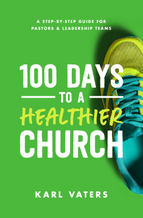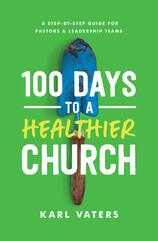
What does a healthy church look like? And can an unhealthy church get healthy in just 100 days? I’ve read lots of books on “healthy church.” This is not one of those books. I know publishers let me read a lot of books before they’re published so that I could promote it. (I know they check how many people actually click on the link and pre-order the book). I also know they get mad when I tell people the book is whatever and to save their money. But I recommend this book for any pastor. This book is not for someone not in ministry. It will be useless to you. But for the pastor or elder, it’s the most practical book I’ve seen, and you could implement it in your church right away. And if you're in ministry, you know Karl Vaters is an expert on this topic. Book comes out March 3rd!
What’s the best way to summarize this book? It’s like a 100-day devotional book. Except, it’s not for personal use; it’s for the Church Leadership Team. And it’s more like a manual than like a quiet time devotional. That’s the format.
The purpose of this manual is to outline practically and specifically all the things that the church must be doing to be healthy. Some things the church may be doing fine, while other practices may have been ignored. This is not a theology book of thoughts and purposes, nor is it like a business book of strategies or church growth. It is a rigorous undertaking by some key leaders of the church to make sure the church has healthy purposes and practices by the end of 100 days. Each day and important leadership meeting is carefully thought out with purpose and ideas. For example, Day 93 is Launch Day (of project) and Day 94 is Assessment. Each day includes “Today’s Big Idea” “Key Verse” “Passage of the Day” and “Thoughts to Consider.” Every single day. There are also about 8 major meetings that are also detailed. Within the 100 days, important issues are tackled, like mission, church culture, culture shift, intentional projects, evangelism, discipleship, spiritual gifts, leadership training, etc.
The last 20 pages of the book covers how to assess after these 100 days have been completed. There are also forms, takeaways, and conversation starter worksheets for the big all-day meetings. Yeah, this is more of a practical handbook, not just an ideas book.
I haven’t taken my own church on this 100-day ride, so I can’t say how well this works. That’s the only way to properly evaluate this book, because it shouldn’t be judged merely on its ideas. There are no new ideas in this book, just like many books out there on physical health are not new ideas. However, does this book work well in the real church world? This book/manual looks well thought out, and practically detailed. Apparently, it has also been used in the real world several times, so it does work in some contexts. Will it work in mine? Will it work in yours? It’s still a good book to pick up. So check it out.
I would like to thank Moody Publishers for an advance copy of this book.
What’s the best way to summarize this book? It’s like a 100-day devotional book. Except, it’s not for personal use; it’s for the Church Leadership Team. And it’s more like a manual than like a quiet time devotional. That’s the format.
The purpose of this manual is to outline practically and specifically all the things that the church must be doing to be healthy. Some things the church may be doing fine, while other practices may have been ignored. This is not a theology book of thoughts and purposes, nor is it like a business book of strategies or church growth. It is a rigorous undertaking by some key leaders of the church to make sure the church has healthy purposes and practices by the end of 100 days. Each day and important leadership meeting is carefully thought out with purpose and ideas. For example, Day 93 is Launch Day (of project) and Day 94 is Assessment. Each day includes “Today’s Big Idea” “Key Verse” “Passage of the Day” and “Thoughts to Consider.” Every single day. There are also about 8 major meetings that are also detailed. Within the 100 days, important issues are tackled, like mission, church culture, culture shift, intentional projects, evangelism, discipleship, spiritual gifts, leadership training, etc.
The last 20 pages of the book covers how to assess after these 100 days have been completed. There are also forms, takeaways, and conversation starter worksheets for the big all-day meetings. Yeah, this is more of a practical handbook, not just an ideas book.
I haven’t taken my own church on this 100-day ride, so I can’t say how well this works. That’s the only way to properly evaluate this book, because it shouldn’t be judged merely on its ideas. There are no new ideas in this book, just like many books out there on physical health are not new ideas. However, does this book work well in the real church world? This book/manual looks well thought out, and practically detailed. Apparently, it has also been used in the real world several times, so it does work in some contexts. Will it work in mine? Will it work in yours? It’s still a good book to pick up. So check it out.
I would like to thank Moody Publishers for an advance copy of this book.



 RSS Feed
RSS Feed
